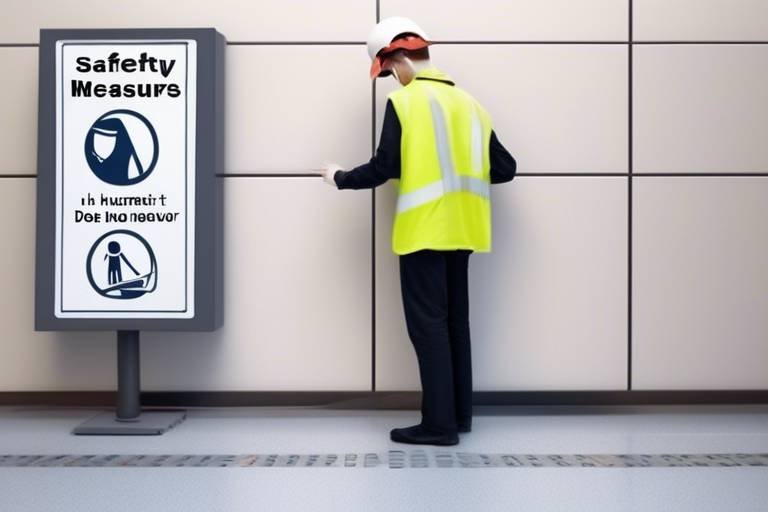Bridging Safety Measures and Human Behavior: Is There a Link?
When we think about safety measures, we often envision strict protocols, safety gear, and checklists. But what if I told you that the effectiveness of these measures is deeply intertwined with human behavior? It's a fascinating concept, isn't it? The reality is that no matter how robust the safety protocols are, they can only be as effective as the people who implement them. This article dives deep into the intricate relationship between safety measures and human behavior, exploring how psychological factors shape our adherence to safety practices.
Imagine a workplace where safety measures are not just rules but part of the culture. In such environments, employees are not merely following orders; they are actively participating in creating a safer workplace. This participation is driven by a complex interplay of motivation, risk perception, and social norms. Understanding these psychological factors is crucial for organizations aiming to enhance their safety protocols. After all, if we can grasp what makes individuals tick regarding safety, we can implement measures that resonate with them on a deeper level.
Moreover, consider how different environments—be it a construction site, a laboratory, or an office—require tailored safety measures. Each context presents unique challenges and risks, and thus, the human behavior associated with safety compliance varies significantly. For instance, in high-risk industries, the perception of danger might be heightened, leading to stricter adherence to safety protocols. Conversely, in less hazardous environments, complacency can set in, causing individuals to overlook essential safety practices. This discrepancy raises an important question: how can we bridge this gap to ensure that safety measures are respected across all contexts?
To tackle this challenge, organizations must not only focus on implementing safety measures but also on fostering an environment where safety is a shared value. This involves engaging employees in safety discussions, providing effective training, and cultivating a culture of accountability. When employees feel that their input matters, they are more likely to comply with safety protocols. This is where the link between safety measures and human behavior becomes evident—it's not just about rules; it's about creating a mindset that prioritizes safety.
In summary, the relationship between safety measures and human behavior is complex yet crucial. By understanding the psychological factors that drive compliance and fostering an organizational culture that values safety, we can create environments where safety measures are not only implemented but embraced. This article will further explore these themes, providing insights into how we can improve safety practices through a better understanding of human behavior.
- What are the key psychological factors influencing safety compliance? The main factors include motivation, perception of risk, and the influence of social norms.
- How can organizations improve safety behavior among employees? By engaging employees in safety initiatives, providing effective training, and fostering a culture of safety.
- What role does leadership play in promoting safety culture? Leaders set the tone for safety practices through their actions and communication, influencing employee behavior significantly.
- Why is measuring safety behavior important? It helps organizations evaluate the effectiveness of safety measures and identify areas for improvement.

The Psychology of Safety Compliance
Understanding the intricate web of psychological factors that drive individuals to comply with safety measures is crucial for any organization aiming to enhance its safety protocols. Think about it: why do some people strictly adhere to safety rules while others seem to disregard them? This divergence often stems from various motivations, perceptions of risk, and the influence of social norms. When we delve into these aspects, we uncover the hidden layers that shape our behaviors in response to safety measures.
First and foremost, motivation plays a pivotal role. People are generally motivated by intrinsic and extrinsic factors. Intrinsic motivation might include a personal commitment to safety or a desire to protect oneself and others. On the other hand, extrinsic motivation could involve the fear of penalties or a desire for rewards. For instance, an employee might wear a hard hat not just to comply with company policy but also to avoid fines or to earn praise from supervisors. This duality of motivation can significantly influence how seriously safety measures are taken.
Next, we have the perception of risk. How individuals perceive risk can dramatically affect their compliance with safety protocols. If someone believes that a task is low-risk, they may be less likely to follow safety measures. Conversely, if they view the situation as dangerous, they are more likely to adhere to safety guidelines. This perception can be shaped by past experiences, training, and even the opinions of peers. For example, if a worker has previously witnessed an accident due to negligence, their perception of risk will be heightened, leading to stricter compliance.
Social norms also play a crucial role in shaping safety behavior. People often look to their peers to gauge what is acceptable behavior within a given context. If a workplace culture promotes safety as a shared value, employees are more likely to engage in safe practices. Conversely, if non-compliance is the norm, individuals may feel pressured to follow suit. This is where the influence of leadership becomes evident; leaders who prioritize safety can create an environment where compliance is not just expected but celebrated.
To summarize, the psychology of safety compliance is a complex interplay of motivation, risk perception, and social influence. By understanding these elements, organizations can tailor their safety programs to foster an environment where compliance is not just a requirement but a shared value among all employees. This approach can lead to a more robust safety culture, ultimately reducing the likelihood of accidents and injuries in the workplace.
- What are the key factors influencing safety compliance? The main factors include motivation, perception of risk, and social norms.
- How can organizations improve safety compliance? By understanding psychological factors and creating a positive safety culture that encourages adherence to safety measures.
- What role does leadership play in safety compliance? Leaders set the tone for safety culture; their actions and communication can significantly influence employee behavior.

Impact of Training on Safety Behavior
The impact of training on safety behavior cannot be overstated. When we think about safety in the workplace or any environment, the first thing that comes to mind is often the protocols and measures in place. However, the real magic happens when individuals are equipped with the knowledge and skills to follow these protocols effectively. Training acts as a bridge between safety measures and human behavior, transforming theoretical knowledge into practical application. It's like teaching someone to ride a bike; you can provide all the safety gear, but without practice, they might not know how to balance or steer properly.
Effective training programs are designed not only to inform but also to inspire. They help individuals understand the **importance of safety** and the **consequences of negligence**. For instance, in high-risk industries such as construction or manufacturing, the stakes are incredibly high. A single mistake can lead to serious injuries or even fatalities. Thus, the training provided must be robust, engaging, and relevant. It should resonate with the employees on a personal level, making them realize that safety is not just a set of rules, but a culture that they must embody.
Moreover, the **methods of training** can significantly influence safety behavior. Traditional classroom settings have their place, but they often lack the engagement needed to truly impact behavior. Hands-on experiences, interactive workshops, and real-life simulations can make a world of difference. For example, consider a fire safety training session that includes a live demonstration of using a fire extinguisher. Participants are not just passive listeners; they are actively involved, which reinforces their learning and retention. This practical application is crucial, as it prepares employees for real-world scenarios where they must react quickly and efficiently.
Different industries implement various safety training programs tailored to their specific needs. Here are some common types:
- On-the-Job Training: This method provides employees with hands-on experience in their actual work environment. It allows them to learn safety protocols in context, which can significantly enhance their understanding and compliance.
- Simulation-Based Training: Offering a risk-free environment, simulation training allows individuals to practice safety protocols without the real-world consequences. This is particularly effective in preparing for emergencies.
- Workshops and Seminars: These are often used to educate employees about safety regulations and best practices, fostering a culture of awareness and compliance.
In conclusion, training is a powerful tool that shapes safety behavior. It not only equips individuals with the necessary skills but also instills a sense of responsibility towards their own safety and that of their colleagues. By investing in quality training programs, organizations can create a safer workplace where employees feel confident and prepared to handle potential risks.
Q1: Why is training important for safety behavior?
A1: Training is essential because it equips individuals with the knowledge and skills to follow safety protocols effectively, reducing the risk of accidents and injuries.
Q2: What types of training are most effective for promoting safety?
A2: Hands-on training methods, such as on-the-job training and simulation-based training, are often the most effective as they provide practical experience in a controlled environment.
Q3: How can organizations measure the effectiveness of their safety training programs?
A3: Organizations can measure effectiveness through assessments, feedback from participants, and tracking compliance rates before and after training sessions.

Types of Safety Training Programs
When it comes to safety training programs, one size certainly does not fit all. Different industries face unique challenges and hazards, which necessitates tailored training approaches. Understanding the available can help organizations choose the most effective methods to ensure their employees are well-prepared to handle potential risks. Let's dive into some of the most common types of safety training programs that are making waves across various sectors.
First up, we have the traditional classroom-based training. This method involves instructors delivering lectures, presentations, and discussions in a structured environment. While it can be effective for conveying essential information, it often lacks engagement, which is crucial for retention. Think of it like trying to learn to swim by reading a book—helpful, but not nearly as effective as getting in the water!
Next on the list is on-the-job training. This approach allows employees to learn safety protocols in real-time while performing their actual job responsibilities. Imagine a new firefighter learning the ropes by shadowing a seasoned pro during a live emergency. This hands-on experience is invaluable, as it reinforces safety measures through practical application. However, it does come with its own set of challenges, such as the potential for distractions or unsafe conditions during training.
Another popular method is simulation-based training. This technique creates a risk-free environment where employees can practice safety protocols without the fear of real-world consequences. For instance, medical professionals can rehearse emergency procedures using mannequins and virtual reality scenarios, allowing them to refine their skills and responses. This method not only enhances knowledge retention but also boosts confidence, making it easier for individuals to react effectively in actual emergencies.
Moreover, we can't overlook e-learning and online courses. With the rise of technology, many organizations are turning to digital platforms to deliver safety training. These courses offer flexibility and can be accessed anytime, anywhere, making them ideal for busy employees. However, it's essential to ensure that these programs are interactive and engaging to keep learners invested. Just like binge-watching your favorite series, if the content is captivating, you’ll stick with it!
In summary, the effectiveness of safety training programs hinges on their ability to resonate with employees and address the specific challenges they face in their respective environments. By leveraging a mix of training types—classroom instruction, on-the-job training, simulation exercises, and e-learning—organizations can create a comprehensive safety training strategy that not only informs but also empowers their workforce.
- What is the most effective type of safety training? The effectiveness of safety training varies by industry and individual needs. A combination of on-the-job training and simulation-based training often yields the best results.
- How often should safety training be conducted? Regular training is essential. Many organizations conduct safety training annually, but high-risk industries may require more frequent sessions.
- Can safety training reduce workplace accidents? Yes! Effective safety training equips employees with the knowledge and skills to recognize hazards and respond appropriately, significantly reducing the likelihood of accidents.

On-the-Job Training
On-the-job training (OJT) is a powerful method of teaching employees the skills they need to perform their jobs effectively while immersing them in the actual work environment. Imagine learning to ride a bike by just reading about it versus actually getting on one and pedaling down the street. That’s the essence of OJT – it’s all about hands-on experience. This approach not only helps in reinforcing safety measures but also builds confidence in employees as they navigate their roles.
One of the key benefits of OJT is its immediate applicability. When employees learn safety protocols in the context of their daily tasks, they are more likely to remember and apply those practices. For instance, a construction worker who learns about safety gear while on-site is more likely to understand the importance of wearing a helmet when they can see firsthand the potential hazards around them. This real-world exposure creates a sense of urgency and relevance that traditional training methods often lack.
However, implementing OJT isn’t without its challenges. It requires experienced trainers who can effectively communicate safety protocols while also allowing for hands-on practice. Moreover, the variability in learning styles means that not every employee will benefit equally from this method. Some may thrive in a practical environment, while others might need additional support or resources to grasp safety concepts fully. Therefore, it’s essential to tailor the OJT experience to meet diverse needs, ensuring that all employees feel equipped to adhere to safety standards.
To maximize the effectiveness of on-the-job training, organizations should consider the following strategies:
- Mentorship Programs: Pairing new employees with experienced mentors can facilitate knowledge transfer and provide a safety net for questions and concerns.
- Regular Feedback: Providing constructive feedback during OJT sessions helps employees understand areas for improvement, reinforcing safe practices.
- Documentation: Keeping a record of training sessions and safety compliance can help track progress and identify areas needing further attention.
In conclusion, on-the-job training is not just about teaching employees how to do their jobs; it’s a critical component of fostering a culture of safety. By engaging employees in their learning process, organizations can create a safer work environment and enhance overall productivity. Remember, the goal is to ensure that safety becomes second nature to every employee, and OJT is a vital step in achieving that.

Simulation-Based Training
When it comes to safety training, stands out as a powerful tool that provides employees with a unique opportunity to practice safety protocols in a controlled, risk-free environment. Imagine being able to face a potential emergency situation without the real-world consequences—this is exactly what simulation training offers. By immersing individuals in realistic scenarios, they can develop the skills and confidence needed to respond effectively when the stakes are high.
One of the most significant advantages of simulation-based training is its ability to create a realistic experience. Participants can engage with virtual environments that mimic their actual workplace, allowing them to familiarize themselves with the specific challenges they might face on the job. This method not only enhances retention of safety protocols but also fosters a deeper understanding of the consequences of unsafe behavior. For instance, in industries such as aviation or healthcare, where the margin for error is minimal, simulation training can be a game-changer.
Furthermore, simulation-based training can be tailored to meet the unique needs of different industries. Whether it’s a fire drill for a construction site or a medical emergency scenario for healthcare professionals, the training can be customized to reflect the specific risks associated with each field. This tailored approach ensures that employees are not just going through the motions but are genuinely prepared for the situations they are likely to encounter.
Another noteworthy aspect of simulation training is the immediate feedback it provides. Participants can receive real-time evaluations of their performance, allowing them to identify areas for improvement on the spot. This instant feedback loop is crucial for reinforcing safe practices and ensuring that employees leave the training with a clear understanding of how to enhance their safety behavior. Moreover, it encourages a culture of continuous learning, where individuals are motivated to refine their skills continually.
However, implementing simulation-based training does come with its challenges. It can require significant investment in technology and resources, which may be a barrier for some organizations. Additionally, some employees may initially feel apprehensive about participating in simulations, fearing judgment or embarrassment if they make mistakes. To address these concerns, it’s essential to cultivate a supportive atmosphere where mistakes are viewed as learning opportunities rather than failures. This shift in perspective can empower employees to engage fully with the training process.
In conclusion, simulation-based training is an invaluable tool in the realm of safety education. By providing a safe space to practice, receive feedback, and learn from mistakes, organizations can significantly enhance their employees' preparedness for real-world emergencies. As industries continue to evolve, embracing innovative training methods like simulation will be crucial in fostering a culture of safety that prioritizes the well-being of all employees.
- What is simulation-based training?
Simulation-based training involves creating realistic scenarios that allow individuals to practice safety protocols in a controlled environment, enhancing their readiness for real-life situations. - What are the benefits of simulation training?
Some benefits include realistic experiences, immediate feedback, tailored training for specific industries, and the opportunity to learn from mistakes without real-world consequences. - How can organizations implement simulation training?
Organizations can implement simulation training by investing in technology, developing customized scenarios, and fostering a supportive learning environment that encourages participation and growth.

Measuring Safety Behavior
Quantifying safety behavior is not just a box-ticking exercise; it is a vital process that allows organizations to gauge how effectively their safety measures are being implemented. By measuring safety behavior, companies can identify strengths and weaknesses in their safety protocols, leading to improved practices and ultimately a safer workplace. But how do we go about this? The answer lies in a combination of qualitative and quantitative methods.
One of the most common approaches to measuring safety behavior is through direct observation. Trained safety personnel can monitor employees in real-time, assessing their adherence to safety protocols. This method allows for immediate feedback and can be incredibly effective in identifying unsafe practices. However, it is crucial to approach this method with care; employees may alter their behavior if they know they are being watched, a phenomenon known as the Hawthorne effect. Therefore, it is essential to conduct observations in a way that minimizes this effect, perhaps by integrating it into regular operations.
Another effective method is the use of surveys and questionnaires. These tools can gather insights into employee perceptions of safety measures and their own behaviors. Questions can range from how often employees use personal protective equipment (PPE) to their understanding of emergency procedures. The results can reveal trends and areas needing attention. However, the effectiveness of surveys often depends on the honesty of the responses, which can be influenced by the organizational culture. If employees feel that their feedback will lead to punitive measures, they may not respond truthfully.
To better illustrate the various methods used to measure safety behavior, consider the following table:
| Method | Description | Advantages | Disadvantages |
|---|---|---|---|
| Direct Observation | Monitoring employees in real-time to assess compliance. | Immediate feedback; identifies unsafe practices. | May alter behavior due to being watched. |
| Surveys and Questionnaires | Gathering employee perceptions through structured questions. | Can reveal trends; anonymous responses encourage honesty. | Responses may be biased; depends on organizational culture. |
| Incident Reporting | Tracking safety incidents and near misses. | Provides data on actual safety failures. | May not capture all unsafe behaviors; requires a reporting culture. |
Additionally, organizations can analyze incident reports and near misses to assess safety behavior comprehensively. By examining what went wrong and understanding the circumstances surrounding incidents, companies can identify patterns and take proactive measures to mitigate risks. However, fostering a culture where employees feel safe to report incidents without fear of repercussions is crucial for this method to be effective.
Finally, incorporating key performance indicators (KPIs) related to safety can provide a quantitative measure of safety behavior. KPIs might include the number of safety training sessions completed, the frequency of safety audits, or the rate of compliance with PPE usage. By tracking these metrics over time, organizations can evaluate their safety performance and make informed decisions about where to focus their improvement efforts.
In conclusion, measuring safety behavior is a multifaceted process that requires a combination of methods to ensure a comprehensive understanding of how safety measures are being adhered to. By employing direct observation, surveys, incident reporting, and KPIs, organizations can create a robust framework for enhancing safety practices. The ultimate goal is to foster a culture of safety where employees are engaged, informed, and empowered to take ownership of their safety practices.
- What is the best method for measuring safety behavior? There is no one-size-fits-all method. A combination of direct observation, surveys, and incident reporting often yields the best results.
- How can organizations encourage honest feedback in surveys? Ensuring anonymity and emphasizing that feedback will be used for improvement, not punishment, can help encourage honesty.
- Why is it important to measure safety behavior? Measuring safety behavior helps identify areas for improvement, enhances compliance, and ultimately contributes to a safer workplace.

Influence of Organizational Culture on Safety
When we talk about safety in the workplace, it's impossible to ignore the role of organizational culture. Think of it as the invisible glue that holds everything together. It's the set of shared values, beliefs, and practices that shape how employees behave and interact with safety protocols. A strong safety culture can mean the difference between a workplace where safety is prioritized and one where it’s an afterthought. But what exactly influences this culture? Let's dive in!
First off, leadership plays a pivotal role in shaping safety culture. Leaders are like the captains of a ship; their direction and attitude set the course for everyone else. When leaders prioritize safety, communicate its importance, and lead by example, employees are more likely to follow suit. This is not just about having safety meetings; it’s about creating an environment where safety is a core value. For instance, if a manager consistently wears protective gear and encourages others to do the same, it sends a clear message: Safety matters.
Moreover, communication is another critical factor. Open lines of communication enable employees to voice concerns about safety without fear of retribution. Imagine a workplace where everyone feels comfortable reporting hazards or suggesting improvements. In such an environment, safety becomes a shared responsibility. Regular safety meetings, feedback sessions, and anonymous reporting systems can foster this culture of openness.
Shared values also contribute significantly to a robust safety culture. When employees believe in the importance of safety, they are more likely to engage in safe practices. For example, organizations that celebrate safety milestones or recognize employees for safe behavior create a sense of community and collective responsibility. This can be further enhanced by integrating safety into the company’s mission statement and core values.
However, it's essential to acknowledge that barriers exist. Sometimes, despite the best intentions, organizational culture can inadvertently hinder safety compliance. For instance, if there's a culture of rushing to meet deadlines, employees might feel pressured to cut corners, putting safety at risk. Identifying these barriers is crucial for fostering a culture where safety is not compromised for productivity.
To sum it up, the influence of organizational culture on safety is profound. It shapes behaviors, encourages communication, and establishes norms that either promote or hinder safe practices. By focusing on leadership, communication, and shared values, organizations can cultivate a culture that prioritizes safety, ensuring that every employee feels responsible for their own safety and the safety of their colleagues.
- What is organizational culture? Organizational culture refers to the shared values, beliefs, and practices that shape how employees behave within a company.
- How does leadership affect safety culture? Leadership sets the tone for safety culture by prioritizing safety measures, leading by example, and fostering open communication.
- Can communication improve safety compliance? Yes, open communication allows employees to report hazards and suggest improvements, fostering a proactive safety environment.
- What are some barriers to safety compliance? Common barriers include pressure to meet deadlines, lack of training, and insufficient communication regarding safety protocols.

Leadership’s Role in Safety Culture
When it comes to establishing a robust safety culture within an organization, the role of leadership cannot be overstated. Leaders set the tone for safety practices and behaviors, influencing how employees perceive and prioritize safety. Imagine a ship navigating through rough seas; the captain's decisions and actions directly affect the crew's safety and morale. Similarly, effective leaders in the workplace steer their teams toward a culture that values safety above all else.
One of the most critical aspects of leadership in fostering a safety culture is communication. Leaders must consistently communicate the importance of safety measures, not just through memos or meetings, but through their daily actions and interactions. When leaders demonstrate a commitment to safety, employees are more likely to mirror that behavior. For instance, if a manager uses personal protective equipment (PPE) and follows safety protocols diligently, it sends a powerful message to the team: safety is a priority.
Furthermore, leaders should engage in open dialogues about safety concerns. This can be achieved through regular safety meetings or informal check-ins where employees feel comfortable voicing their concerns. By fostering an environment of open communication, leaders can identify potential hazards and address them proactively. This not only enhances safety but also builds trust between employees and management, creating a more cohesive and safety-conscious workplace.
Another essential element is leading by example. Leadership behaviors significantly influence employee attitudes toward safety. When leaders prioritize safety in their decision-making processes, it reinforces the notion that safety is everyone’s responsibility. For example, if a leader decides to halt operations due to unsafe conditions, it shows a commitment to safety that resonates throughout the organization. Employees are more likely to follow suit, adopting similar attitudes toward safety in their work.
To illustrate the impact of leadership on safety culture, consider the following table that highlights key leadership behaviors and their effects on employee safety compliance:
| Leadership Behavior | Effect on Safety Compliance |
|---|---|
| Consistent Communication | Increases awareness and prioritization of safety measures |
| Leading by Example | Encourages employees to adopt safety practices |
| Open Dialogue | Helps identify hazards and fosters trust |
| Recognition of Safe Practices | Motivates employees to maintain compliance |
In conclusion, leadership plays a pivotal role in shaping a safety culture. By prioritizing safety, communicating effectively, and leading by example, leaders can create an environment where safety is ingrained in the organizational fabric. When employees see their leaders actively participating in safety initiatives, they are more likely to embrace those practices themselves. After all, a strong safety culture is not just about rules and regulations; it’s about creating a shared commitment to safety that permeates every level of the organization.

Employee Engagement and Safety
When it comes to fostering a culture of safety within an organization, employee engagement plays a pivotal role. Imagine a workplace where every individual feels not just responsible for their own safety, but also for their colleagues. This sense of community can transform the way safety measures are perceived and implemented. Engaging employees in safety initiatives is not merely a checkbox on a compliance list; it’s about creating a dynamic environment where safety is woven into the very fabric of daily operations.
One of the most effective ways to enhance engagement is through open communication. When employees feel their voices are heard, they are more likely to participate actively in safety discussions. This can be achieved through regular safety meetings, suggestion boxes, or even informal chats during breaks. For instance, consider a scenario where a worker identifies a potential hazard in the workplace. If they feel comfortable sharing their concerns, not only does it promote a safer environment, but it also reinforces a culture of trust and collaboration.
Moreover, involving employees in safety decision-making processes can lead to innovative solutions that management might overlook. When employees contribute their insights, they bring a unique perspective based on their daily experiences. This collaborative approach not only empowers workers but also fosters a sense of ownership over safety practices. As a result, employees are more likely to adhere to safety protocols when they feel they have a stake in the outcome.
Another effective strategy is to implement safety recognition programs. Recognizing and rewarding employees for their commitment to safety can create a positive feedback loop. When individuals see their efforts acknowledged, it motivates them and their peers to prioritize safety even more. For example, companies can establish a monthly safety award for teams that demonstrate exemplary safety practices. This not only boosts morale but reinforces the importance of safety in the workplace.
However, it’s crucial to remember that engagement is not a one-time effort; it requires ongoing commitment. Regular training sessions, safety drills, and refreshers can keep safety at the forefront of employees' minds. Furthermore, creating a feedback loop where employees can discuss the effectiveness of safety measures and suggest improvements is vital. This continuous dialogue ensures that safety measures evolve alongside the workforce and its needs.
In summary, employee engagement in safety is about creating a culture where everyone feels responsible and empowered. By fostering open communication, involving employees in decision-making, recognizing their efforts, and maintaining ongoing training, organizations can significantly enhance their safety culture. It’s a win-win situation: safer workplaces lead to happier employees, and happier employees contribute to a more productive organization.
- Why is employee engagement important for safety?
Employee engagement is crucial because it fosters a sense of ownership and responsibility, leading to higher compliance with safety measures and a proactive approach to identifying hazards. - How can organizations improve employee engagement in safety?
Organizations can improve engagement by promoting open communication, involving employees in safety discussions, recognizing their contributions, and providing continuous training. - What are some effective recognition programs for safety?
Effective recognition programs can include monthly safety awards, shout-outs during meetings, and incentives for teams that meet safety goals.

Barriers to Safety Compliance
When it comes to safety compliance, the road can often be bumpy. Individuals and organizations alike face a myriad of barriers that can hinder adherence to safety measures. Understanding these barriers is crucial because, just like a chain is only as strong as its weakest link, safety practices can only be as effective as the compliance of the people involved. So, what are these barriers that stand in the way of a safer environment?
One of the primary obstacles is the perception of risk. Many individuals may underestimate the dangers associated with their tasks, leading them to believe that safety measures are unnecessary. For instance, a construction worker might think, "I’ve done this a hundred times without incident," which can create a false sense of security. This mindset can be particularly dangerous, as it often results in complacency, where safety protocols are ignored or deemed irrelevant.
Another significant barrier is inadequate training. If employees do not receive proper instruction on safety measures, they may not fully understand how to implement them effectively. Imagine trying to navigate a complex machine without a manual; you might get lucky, but the odds are against you. Similarly, without comprehensive training, employees may not recognize hazardous situations or know how to react appropriately. This lack of knowledge can lead to accidents that could have been easily avoided.
Moreover, organizational culture plays a crucial role in shaping safety behavior. If the culture within an organization does not prioritize safety, employees are less likely to comply with safety measures. For example, if management overlooks safety violations or fails to provide the necessary resources for compliance, employees may feel that safety is not a priority. This creates an environment where cutting corners becomes the norm rather than the exception.
Additionally, there are psychological factors at play. Fear of reprimand or a lack of support can prevent employees from reporting unsafe conditions or practices. When individuals feel that they might be penalized for speaking up, they are likely to stay silent, even if they know something is wrong. This silence can perpetuate unsafe practices and create a cycle of non-compliance.
To further illustrate these barriers, consider the following table that outlines common obstacles and potential strategies to overcome them:
| Barrier | Description | Potential Strategy |
|---|---|---|
| Perception of Risk | Underestimating dangers associated with tasks. | Regular risk assessments and awareness programs. |
| Inadequate Training | Lack of proper instruction on safety measures. | Implement comprehensive training programs. |
| Organizational Culture | Culture that does not prioritize safety. | Leadership commitment to safety initiatives. |
| Psychological Factors | Fear of reprimand for reporting unsafe conditions. | Create a supportive environment for reporting. |
In conclusion, addressing these barriers is essential for fostering a culture of safety within any organization. By recognizing the challenges and implementing strategic solutions, we can bridge the gap between safety measures and human behavior, ultimately leading to a safer and more compliant workplace.
Q: What are the most common barriers to safety compliance?
A: Common barriers include perception of risk, inadequate training, organizational culture, and psychological factors such as fear of reprimand.
Q: How can organizations improve safety compliance?
A: Organizations can improve compliance by providing comprehensive training, fostering a positive safety culture, and encouraging open communication about safety concerns.
Q: Why is understanding human behavior important in safety compliance?
A: Understanding human behavior helps organizations identify the reasons behind non-compliance, allowing them to tailor safety measures and training to better fit the needs of their employees.
Frequently Asked Questions
- What are the key psychological factors that influence safety compliance?
Several psychological factors play a crucial role in safety compliance. These include motivation, individual perception of risk, and the impact of social norms. When people feel motivated to adhere to safety measures, whether through personal beliefs or external pressures, they are more likely to comply. Additionally, how individuals perceive risks can significantly affect their behavior regarding safety protocols.
- How does effective training impact safety behavior in the workplace?
Effective training is essential for enhancing safety behavior among employees. It equips them with the necessary knowledge and skills to recognize hazards and respond appropriately. Training methods like on-the-job training and simulation-based training provide hands-on experience and risk-free environments, respectively, thereby reinforcing safe practices and improving overall safety compliance.
- What types of safety training programs are commonly implemented?
Organizations often implement various types of safety training programs tailored to their specific needs. Common types include on-the-job training, which offers practical experience, and simulation-based training, which allows employees to practice safety protocols in a controlled setting. Each type aims to instill safe behaviors effectively and prepare individuals for real-life situations.
- How can organizational culture influence safety behavior?
Organizational culture significantly shapes safety behavior. A positive safety culture, fostered by effective leadership and open communication, encourages employees to prioritize safety. When shared values and commitment to safety are evident within an organization, employees are more likely to engage in safe practices and adhere to safety measures.
- What barriers do individuals face in complying with safety measures?
Common barriers to safety compliance include lack of awareness, inadequate training, and insufficient management support. These obstacles can hinder individuals from following safety protocols effectively. Identifying and addressing these challenges is crucial for improving overall safety compliance within an organization.
- How can leadership enhance a culture of safety?
Leadership plays a pivotal role in promoting a culture of safety. Leaders can influence employee behavior by demonstrating a commitment to safety through their actions and communication. By actively engaging in safety discussions and prioritizing safety initiatives, leaders can inspire employees to adopt safe practices and contribute to a safer workplace.
- What strategies can be used to engage employees in safety initiatives?
Engaging employees in safety initiatives can be achieved through various strategies, such as involving them in safety discussions, soliciting their feedback on safety practices, and recognizing their contributions to safety efforts. Creating a sense of ownership and responsibility among employees fosters a proactive safety environment and enhances compliance with safety measures.



















